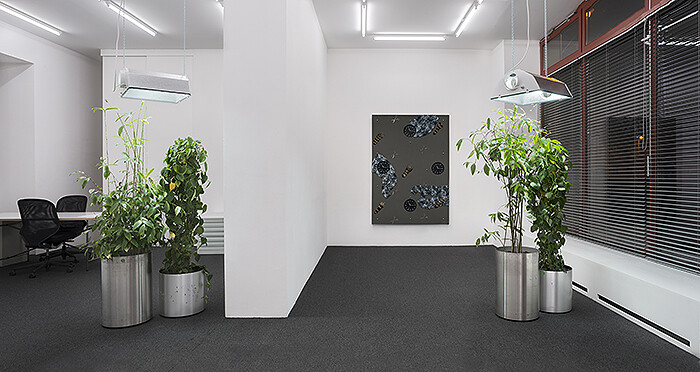Remember Spellbound? In Alfred Hitchcock’s 1945 thriller, Gregory Peck stars as an amnesiac patient whose dreams were famously designed by Salvador Dali. Scissors, eyes, curtains, faceless men, decks of cards—a whole panoply of Surrealist tokens parade before the piercing intellect of Dr. Constance Petersen, played by Ingrid Bergman. Conflating Sigmund Freud and Sherlock Holmes—as Hollywood always does—she approaches the dream sequence as if it were a forensic theater whose clues, once properly deciphered, will identify the murderer. A contorted wheel stands for a gun barrel, while two parallel lines symbolize snow tracks, culminating in the big reveal: it was the hospital’s director, behind the chimney, with the revolver.
Nina Beier’s “Office Nature Nobody Pattern” at Croy Nielsen also plays with the unequivocal literalness of psychoanalytic symbols. In what one could call a portrayal of the “office unconscious,” the gallery’s off-white floor is covered in grey industrial carpet topped with large potted plants—which the artist, in collaboration with Simon Dybbroe Møller, repurposed from the auction of a bankrupt Danish bank’s assets. These stand under hanging lights, and PVC blinds cover the wide window. Aside from some vegetable crates, half-spilled, in the entrance, the room looks like an anonymous bank branch. Hung at both ends of the space, two large wall pieces made of packaging foam with several object inlays frame the exhibition. Slow Foxtail Separation Rock Pattern (2014) in the front room contains wall clocks, scissors, foxtail key chains, and marble-dye leggings, and Office Nature Nobody Pattern (2014) displays two Hermès vegetable-pattern neckties. All of the clocks’ hands are stopped at ten minutes past ten. One feels tempted to play “Sigmund Holmes” and take all this crude symbolism at face value. Open scissors and foxtails representing a fear of castration, neckties standing in for the phallus, and clocks referring to female genitalia. But why is that scattered Arcimboldo inside my Dali? And more importantly: whodunit?
After a cursory online search, I came across the claim that all analog clocks used in advertisements display the time of 10:10, as an obscure homage to the exact moment John F. Kennedy was shot. The artist, on the contrary, explains that 10:10 has become the industry standard because advertisers wanted to make sure their logos were visible. Downward pointing hands were seen as bad marketing practice, whereas upward pointing ones implied a smiley face or a victory “V.” Fittingly, an online keyword generator, which was originally devised to tag stock photographs with easily graspable descriptions, composed the title of the exhibition, “Office Nature Nobody Pattern.” In a bid to automate nutritional options as well, for Scheme (2014), Beier signed the gallery up for a local vegetable box service, which will deliver fresh seasonal produce—apples, beets, carrots, squash, turnips—over the course of the show, with the sprawl of organic yield mimicking the print in the Hermès neckties. Needless to say Hermès is famous for its decorous, equestrian imagery, which connotes tradition, craftsmanship, and authenticity as well as colonialism, peerage, and affluence. But then again, all images are double-edged swords.
Surrealist images were developed in an attempt to undo what Freud called sublimation—the process whereby all sexual instincts are diverted towards non-sexual ends—in order to restore the real of desire. Yet, despite its proponents’ exploitation of Freudian motifs, they had no use for psychotherapy. For them, images had an intrinsic agency, a dialectical ability to bridge libido and matter-of-factness. I wonder what Breton would have made of the most (in)famous subgenre of stock images: women laughing while eating salad (Google it up!). But what does it take to recognize an image as an image? Hermès textile patterns, much like keyword generators, have an underlying mathematical structure, whose elements repeat with self-similar regularity. The soothing cadence of this recurrence renders all motifs, however disturbing, into a comforting lull—which is why we tend to see appealing ornaments and pleasant shapes instead of maimed animals and class signifiers.
Though there is no hint of violence in the show, violence is the leading thread of the exhibition. Not the callous Victorian violence that haunts the psychoanalytic subject, but rather the subtler violence of sublation, whereby all nature gets devoured and then spewed out as stock photography and chintzy prints, online search algorithms, and cubicle-friendly plants.








